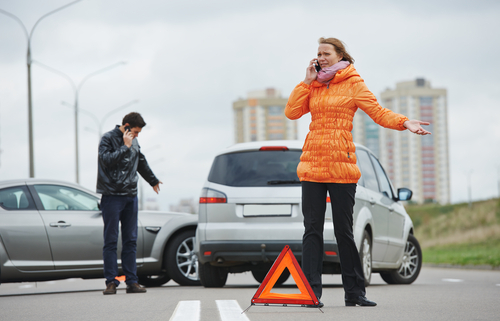Common Car Accident Injuries, Symptoms, and Treatments
A recent Esurance report found that the average driver will experience 3-4 accidents in their lifetime.
Let’s look at some common car accident injuries, symptoms, and treatments (the below list is NOT in order of most common injuries).
1. Internal Bleeding
Your organs are delicate and vulnerable to trauma. These potentially life-threatening injuries are much more likely in high-speed crashes.
Symptoms:
- chest pain
- nausea
- vomiting
- diarrhea
- dizziness
- severe weakness
- losing consciousness
- low blood pressure
- acute visual problems
- numbness
- weakness on one side of the body
- severe headache
- severe abdominal pain
- shortness of breath
Treatment:
Treatment varies depending on the severity. Minor internal bleeding may stop without intervention, but severe internal bleeding may require surgery and extended care (in hospice).
2. Concussions
Concussions or traumatic head injuries are when a sudden stop or impact jolts the brain hard enough to jostle against the inner wall of the skull.
symptoms:
- headache
- ringing in the ears
- nausea
- vomiting
- fatigue or drowsiness
- blurry vision
- confusion or mental fogginess
- blurred vision
treatment:
Doctors DO NOT recommend complete rest in a dark room for days.
In the first few days after a concussion, try to get as much sleep as needed and limit or avoid certain physical and mental activities.
For instance, try to cut back on high-concentration activities such as watching TV, playing video games, reading, and using computers — if these activities make your symptoms worse.
Also, avoid exercise and physical activities for a few days, and continue avoiding them if your symptoms do not improve.
3. Broken Bones
Common broken bone injuries resulting from auto accidents include:
- back and neck vertebrae
- clavicle (shoulder blades)
- fibula (lower leg)
- femur (upper leg)
- cranial (skull)
- facial bones
- sternum (rib cage)
Symptoms:
- sudden, shooting pain
- inability to bear weight
- deformity (bone pushing up or penetrating through the skin)
- limited or no range of motion (in limbs)
- warmth in the affected area
- bruising and redness
Treatment:
Broken bones must be realigned or set so that they heal correctly.
4. Musculoskeletal Injuries
Musculoskeletal injuries include muscles, tendons, ligaments, nerves, discs, and blood vessels. These injuries can be painful and can restrict limb movement.
Example injuries:
- Ligament sprain
- mechanical back syndrome
- Ruptured bulging or herniated discs
Symptoms:
Symptoms vary depending on the location and severity but generally include pain that worsens with activity. The affected area may also look red and inflamed.
Treatment:
Treatment also varies depending on the severity, but generally, treatment plans will include:
- rest
- physical therapy
- anti-inflammatories
- muscle relaxers
- heat/cold therapies
- ergonomics
5. Whiplash (muscle strain)
Though whiplash is a musculoskeletal injury, it’s so common in car accidents that it demands a separate category.
Whiplash is the sudden contorting and stretching of the head and neck muscles that causes muscle strain. It may be helpful to think of the forceful back-and-forth action of a cracking whip.
Most whiplash injuries in car accidents happen during rear-end impacts.
Symptoms:
Signs and symptoms of whiplash usually develop within days of the injury and may include:
- Fatigue
- Dizziness
- Neck pain, stiffness, and lost range of motion
- Worsening of pain with neck movement
- Headaches, most often starting at the base of the skull
- Tenderness or pain in the shoulder, upper back, or arms
- Tingling and numbness in the arms
Treatment:
Your pain management specialist will likely recommend over-the-counter pain medication and exercise, including stretching exercises. Whiplash is a minor injury that heals within weeks.
6. Skin Injuries
Serious skin injuries include:
- cuts
- lacerations
- gashes
- tears
These skin injuries happen when sharp objects penetrate through the skin into the fat tissue. Cuts that measure more than a quarter-inch may need medical attention, and half-inch cuts usually need sutures.
Rug or seatbelt burns, also known as abrasions, are minor skin wounds that don’t penetrate through the skin.
Treatment:
Anti-bacterial treatment and bandages are sufficient for minor skin wounds that don’t penetrate through the skin. Bruises heal on their own within weeks.
Your Pain Specialists in Texas
At Texas Pain Physicians, our patients quickly come to trust our friendly staff and appreciate the benefits of expert care and innovative treatment methodologies and technology.
If you have been injured in a car accident and received initial medical treatment but are still in pain, please give us a call or book your appointment today.



